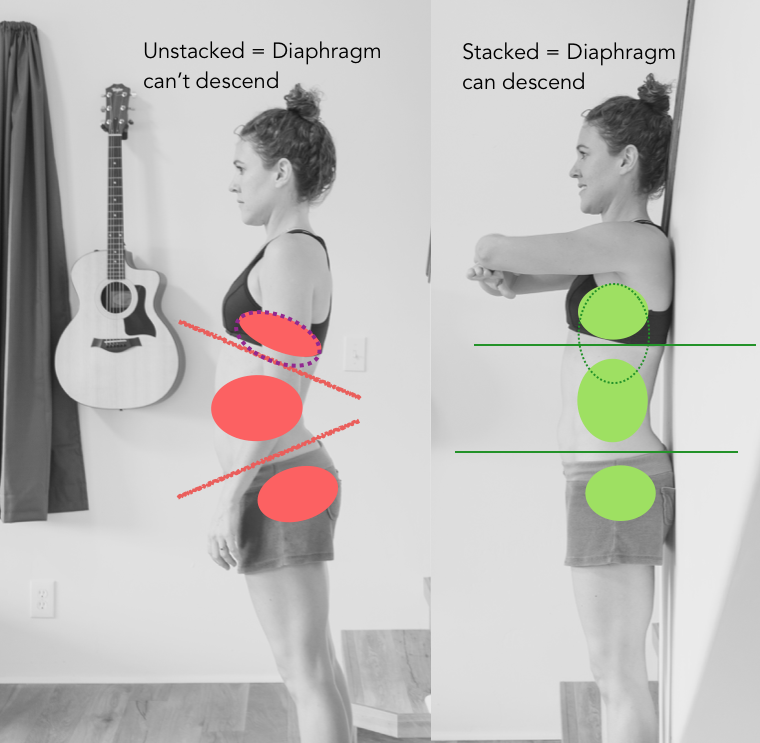The Four Amigas
When I talk about core, I always like to remind women that the “core” is more than we’re led to believe. We usually think of the core as static, like the tube that simply attaches our legs to our upper body. If you have a “strong” core, your tube may have a 6 pack attached. A weak core will look more flabby. But, at the end of the day, our tubes are still there connecting us top and bottom.
Here’s the thing, your tube-like core is actually very dynamic. [Dynamic: characterized by constant change, activity, or progress] Or, it should be. It doesn’t just connect two parts of you, it holds you up, prevents back pain, allows you to breath deep and allows you to sit, bend, and stand tall. So what happens when we’re both so tense and so weak that we’ve tricked our dynamic core into being dysfunctional? Potentially a heck of a lot of lower back pain, knee pain, shallow breathing, anxiety, fatigue, and ENDOMETRIOSIS pain.
First off, What are the four amigas? They're the pieces of your core that move dynamically. They include the
Diaphragm at the top
Pelvic Floor at the bottom
Transverse Abdominus in between
Multifidus up the back
See these 4 in this picture -------------------> and realize your core-tube isn't so static as you once thought.
How the four amigas work
First off, your core is filled with pressure. Really consider this - there are air locks on all sides! Like a soda can. When you breathe into your lungs, air doesn’t rush out of your vagina. No, when you breathe the lungs expand into your body without anything else falling out (hopefully), which means greatly increased pressure inside your body. The way your body deals with this extra pressure is through the mutual trust of the four amigas:
As you breathe in, your ribcage opens wide and your diaphragm widens to make space in your proverbial “soda can” (i.e. abdomen) by opening your ribs.
Then, as the pressure is released (by breathing out), the pelvlc floor lightly contracts to support the pressure moving out. This is why a kegal feels normal during an exhale, but harder/unnatural during an inhale, because your pelvic floor was meant to move with your breath!
All of this can happen while you’re sitting or standing or even bending over through the strength of your transverse abdominis, or TVA, and your multifidus. These are our corset muscles that allow us both strength and relaxation when we need.
How Amigas become Frenemies
I made this one on my computer
If your TVA is weak, your ribcage on lockdown, your pelvic floor brittle, or your tummy tensed, this delicate pressure dance is messed-the-ef-up. What happens instead of a relaxed pressure system is a high-pressure system, and as your lungs bring air into your locked ribcage (stress) and tensed tummy (looking fly in your bikini), there's no where for the pressure to go but down down down to the your lady bits. Check the picture to the right (I edited it a little bit to show you how pressure like this affects your southern region).
This is how something like pelvic organ prolapse can occur, when parts of your rectum, vagina, uterus, or bladder actually pop out of place into your vagina, caused by too much pressure from above slamming on weakened tissue. Never heard of this? Believe me, it's not uncommon at all. This is, of course, a worst-case scenario, but there are also lots of other types of cases in between good and worst-case … such as severe pelvic pain or extreme bloat. Ahem.
Heard of the sneeze pee? Or chronic yoga queefing? Or the pelvic pain when getting up from a deep squat? Do you have a tipped or retroverted uterus? Or any sort of basic pelvic floor dysfunction? I should probably say painful periods and sex too. Do you breathe shallowly, up in your chest? Yup, it’s when your four amigas aren’t working together the way they should and you're getting tons (and I means tons) of pressure down south.
So... how friendly are your own Amigas: 4 tests for the 4 amigas
If you want to check in with your own body and see, you can do a few fun experiments that will shed light on your own core dynamic. Let’s test and see how acquainted your own four amigas are!
Test 1) Cough test
An at home test to see how your abdomen is functioning (or dysfunctioning)?? Yes please! Ok lie down. Put your hands on your belly. Now cough
Did your belly puff outwards, or did it suck slightly in? If it went in, good job! It should suck slightly in as the air is moved OUT of your body. Did it puff out? If so, this means as you displace air out of your body, your diaphragm incorrectly went down, smooshing your organs (including delicate lady parts) downward. This is a sign of current or impending pelvic floor dysfunction. If you're not sure try feeling your belly during a sneeze, this should tell you clearly ;)
Test 2) Movement test
As you’re sitting there reading this, I want you to slowly lift your left arm straight out to the side until it’s shoulder height. There, done? Ok, now check in —— were you holding your breath? Hah, caught you! If you were, this is a good indication you often hold your breath while moving without realizing, showing that your 4 amigas aren’t communicating very effectively and there’s definitely some pressure issues going on.
Why should you always be breathing while you move? Because when we hold our breath we are unknowingly tensing muscles that increases pressure into our bodies (i.e. another punch to the uterus). One of the foundation to healing the pelvic floor and the abdominal wall is to connect to our breath.
Test 3) Check your loaf:
This is one of the best tests ever! Lay on the floor, legs flat, and lift your shirt up so you can see your tummy. First tell her how much you love her, no matter how her TVA behaves. Now, lift your legs up against gravity, using your “core”. Which core did you use, the real strong one or the brittle, pressure inducing one? The way to tell is if your tummy stayed flat(ish) by your hip bones, meaning you engaged your TVA to lift your legs! Good job! If instead you saw a proverbial "loaf" of bread form you actually were using the pressure-powers that be to lift them legs.
In my next blog post I'm going to show you how you may actually be loafing all day long - getting out of bed, out of the car, out of a chair, etc etc. This means you're recruiting pressure to move ya' all day instead of your sexy endo-savior - the TVA. In the meantime, start to watch your "loaf" throughout the day, it's a fun experiment to see how often you find yourself loafing.
Test 4) Posture Check:
You're going to need a real life amiga to help you here, because you want a photo of yourself. Now go ahead, sit (or stand) up straight, have someone snap a picture of you doing this. How were you sitting or standing? Were your amigas aligned, one on top of another? Or, were you thrusting your chest out and arching your back to appear sitting up straight, all the while shearing your spine? Yah, another amigas issue - when you're amigas aren't connected correctly, they can't flow together appropriately because your diaphragm can't descend.
This also shows your TVA isn't strong enough to hold your upper body stable, so you're using your spine to hold you up - ouch :(
Lastly, you may be able to physically see it:
You can often see a 4 Amigas issue with your own eyes. If your body shape looks like the one on the right (as mine did at one point), just remember this is basically a perfect outline of someone with core dysfunction (i.e. an amigas issue). When that pressure occurs, like, every day every hour every minute, it damages the fascia of your lower abdominal area, creating laxity in the tissue. That's why this area can look so pouchy and even be painful, because the tissue is so damaged internally.
If this is you MAKE SURE to start healing anew by a) reading my next blog and b) going to your doc and getting that pelvic floor physio referral, and checking in with Angie at Corerecoverypt.com. Pretty please, just do it???
Want Next Steps to Heal Anew Right Now??
You'll have to read my blog next week on how to start mending the relationships between your amigas :) Friends for life!





